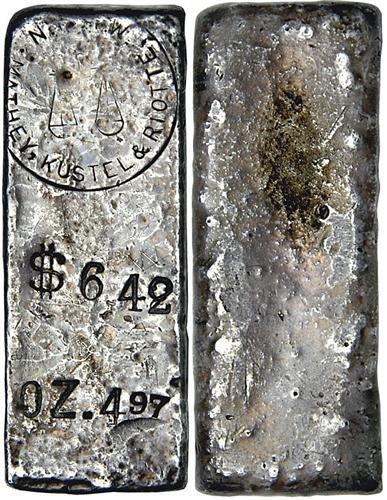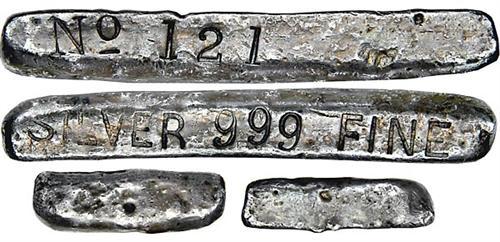This ingot stands out from all others in terms of the amount of documented information, provenance and history available surrounding the assayers whose names are on it. It is unique. No other example of an ingot from this firm has surfaced from other collections to date.
The backgrounds of these mining men, their businesses and the timing of the production of this ingot render it an irreplaceable ingot of great significance. These men formed a partnership with an office in New York to take advantage of the Wall Street financing of western mines, particularly those in Leadville, one of the largest silver discoveries in the history of the world.
Guido Kustel
Guido Kustel was one of the most important mining engineers of his time, spanning the California Gold Rush, early silver mining days of Arizona and the subsequent silver boom on the Comstock in Nevada.
He was born in 1817 in Hungary in a region presently straddling the border between Poland and Ukraine. Kustel attended the prestigious Freiberg School of Mines, where intense training left graduates as assayers, metallurgists and mining engineers.
Kustel came to California, in 1852. Here he leveraged his Hungarian roots practicing his craft as an assayer and metallurgist with firms founded by his fellow countrymen such as Wass Molitor, Wass, Uznay & Co., Haraszthy, Uznay & Co. and their permutations. Haraszthy had been the first supervisor of assaying and refining at the new San Francisco Mint in 1854 and set up a competing firm, the Eureka Gold and Silver Refinery where Kustel was a key player. While employed under Wass, Kustel assisted one of their customers, the Sonora Exploring and Mining Company, in setting up silver refining and assaying operations in the untamed Arizona Territory frontier. Part of his responsibilities involved the famous Heintzelman Silver Mine south of Tucson. In the early fifties, both Wass and John L. Moffat were busy consulting on various mines. Both men spent significant time near Mariposa, California separately investigating both placer and lode deposits for various companies.
Kustel returned to San Francisco in 1860 after Indian hostilities broke out, teaming up with Joseph Mosheimer, a German assayer and metallurgist. . At first they refined the rich Comstock ore in San Francisco. Realizing it was far cheaper and expedient to construct mills near the operating mines, Kustel went to the Comstock and built his own. Kustel later returned to San Francisco and set up a series of assay offices finally partnering with Eugene Riotte, another important assayer in Nevada.
Guido Kustel’s experience in Arizona and on the Comstock led him to write a series of books and articles about ores and metallurgical processes that were landmark efforts. His first book (1863) “Processes of Silver and Gold Extraction, for General Use and for the Mining Public of California and Nevada, with Full Explanations and Directions for All Metallurgical Operations Connected with Silver and Gold from a Preliminary Examination of the Ore to the Final Casting of the Ingot” was a masterpiece. It quickly became one of the standard references for mining and mill men, of particular importance to Comstock interests. He wrote a second book on the treatment of refractory gold and silver ores containing hard to remove sulphides mixed with complex compounds of antimony, arsenic and copper typical of many of Nevada’s mining districts. A third volume was published on roasting complex silver ores and extracting gold without the use of quicksilver. His work on these new methods were a prelude to more modern cyanide based extraction techniques. Kustel died on August 16th, 1882 leaving his son to continue on with the assaying business in San Francisco until 1892.
Eugene Riotte
Eugene N. Riotte was born in Prussia 1843. The family came to the United States in 1848. His father Charles became an important American diplomat to Costa Rica and Nicaragua. Riotte attended the Freiberg mining school, and was hired by past-Freiberg graduates Dr. Adelberg and Rossiter W. Raymond in New York. He accompanied Dr. Adelberg on one of his trips to Nevada in 1865 examining various mining prospects.
Prior to 1865, funding Western mining ventures passed through San Francisco, the financial center of the West. In a way, the Western mining men kept the game “to themselves”, not allowing outsiders “in on” the investments. But by 1865, the New York capital market had “woken up”, and eastern capitalists began to invest in Nevada (and Colorado) mines, especially in The Reese River District. This pair was thus able to garner a lot of work on Nevada properties from New York capitalists. The mining frontier of Nevada impressed Riotte so much he decided to stay, joining H. W. Theall in Austin. Theall was an important assayer having branch offices in Virginia City, NV and Marysville, CA. Theall sold out his Austin office to Boalt & Stetefeldt, ultimately taken over by Riotte who had stayed on through the transition. Riotte assisted Stetefeldt in developing his famous furnace used throughout the West for roasting ore and took over the Auburn Mill near Reno, NV. Meanwhile, Kustel was carefully monitoring the successes of the Stetefeldt Furnace that Riotte had played a pivotal role in and wrote a review for the Mining & Scientific Press.
Riotte moved on to San Francisco to join with well-known assayer Caesar Luckhardt and later ventured into the mining stock brokerage business before teaming up with Kustel in 1879. (Figure 1 advertisement of Kustel & Riotte). Kustel and Riotte recognized that there was a strong need to establish an office in America’s financial center, New York. They needed an experienced partner. That man was Henry Mathey, a French mining engineer. Riotte continued as an assayer and mining engineer headquartered at the New York Metallurgical Works until he died in an accident in 1891 at a North Carolina gold property.
Henry Mathey
Mathey was a mining engineer born around 1835 in France. He emigrated from French Guiana, South America where rich gold deposits were discovered in 1854 that are still mined today. He came to the United States in 1872 and became a naturalized citizen in San Francisco in 1874. He took part in the mining boom at Panamint near Death Valley, and in the Coso Mining District near the mining camp of Darwin, CA. From there he joined Riotte and travelled to New York City in the spring of 1880 to open a branch office known as the New York Metallurgical Works – Mathey, Kustel & Riotte. (Figure 2 Advertisement of and figure 3 Table of Gold and Silver values from the company). It was here that this silver ingot was made probably in late 1880 or early 1881.
Mathey and the New York Metallurgical Works
The trio were particularly good at solving metallurgical problems associated with complex sulfide ores that necessitated roasting. The New York office appears to have been set up to take advantage of the financing of Colorado mines by New York interests. At the time, there was an explosion in exploration in Leadville and in the San Juan Mountains. Prospecting in Colorado was at a record level, and the New York financial market that had missed the California gold rush and the massive Comstock production was eager to jump on board the Colorado mining frenzy.
The lab undoubtedly ran hundreds to thousands of samples from mines financed by New Yorkers. The underwriters of prospecting ventures (also known as grub-staking) were eager to see what the sample results were, and needed a competent “home town” assay lab to manage them.
Guido Kustel died a short while after his partnership with the New York Metallurgical Works ceased to exist. Riotte continued to run the business in New York for almost another decade until his untimely death.
Mathey left the New York Metallurgical Works in late 1884. He had become enthralled with cement, and realized its potential. He became one of the city’s business elite and was a board member of Thomas Edison’s Edison Electric Illuminating Company. Here he met a co-founder of Edison’s company, Jose F. Navarro, a successful industrialist who was impressed with Mathey’s results in manufacturing Portland Cement. He quickly bought the Mathey Cement Company along with all the patent rights. Navarro, a close friend of J. P. Morgan and the principal in Edison’s company, built up the company which eventually supplied the cement for the construction of the Panama Canal. Becoming the Atlas Cement Company, the largest in the world, it would later merge with the United States Steel Corporation which evolved from J.P. Morgan’s buying out Andrew Carnegie at the turn of the century. U. S. Steel was the first corporation in the world with a market capitalization over $1 billion.
Mathey meanwhile went back to his mining roots and developed one of the first producing tin mines, the Temescal Tin Mining Co. in southern California as well as some additional mining ventures in California and Nevada. He is not related to Johnson Matthey & Co. of England.
4.97 oz Mathey, Kustel & Riotte, $6.42, No 121, Silver Assay Ingot


Uncertain location (Nevada or San Francisco, California).
Overall appearance of Fine to Very Fine. Medium silver gray in color. Some scratches, initial “W” scratched on face. Rather rough and unfinished in appearance, a casting that was stamped with no attempt to make the piece presentable and as such, probably a working bar or sample. This is the sole ingot from this company seen thus far. The ethnic was made to resemble the OIR stamp and may serve to suggest a date for this bar in the 1870s and later. This ingot was once in Newcomer’s Collection according to Mehl’s 1931 inventory.
- Face: MATHEY, KUSTEL & RIOTTE in a round logotype, other letters indistinct, scales in the center / $6.42 / OZ.497.
- Back: blank.
- Top side: blank.
- Bottom side: blank.
- Left side: SILVER 999 FINE.
- Right side: No. 121.
- Dimensions: 67.0 x 25.5 x 9.8 mm.
- Current weight: 154.4 gms.
From the John J. Ford, Jr. Collection
Provenance: Mr. Ford’s informational card that accompanies the lot notes this bar was in the Kagin Collection on December 14, 1957. Recently, George Fuld found this bar on Mehl’s 1931 inventory of the Waldo C. Newcomer Collection.
[10/2007] https://auctions.stacksbowers.com/lots/view/3-AV6N9/mathey-kustel-riotte-uncertain-location-nevada-or-san-francisco-california-silver-assay-ingot-no-121 ($43,125)
Description
The ingot carries the Mathey, Kustel & Riotte logo punch, which, with this ingot, is unique. It carries a value of $6.42 and weighs 4.97 ozs. “999 fine” is punched on one side, and the serial number “No. 121” is punched on the opposing side. The reverse of the ingot is blank. There are no assay chips, which is a typical attribute of refined silver (and gold).
Provenance
Waldo C. Newcomer Collection; B. Max Mehl (1931); Art Kagin; John J. Ford (1957); current owner, John J. Ford Jr. Part XXI sale, 2007, lot 3524. Realized $43,125.
This important and unique assayer ingot is the subject of a recent book, “The Anatomy of an Ingot”, by Paul Franklin (2012). Franklin examined all of the businesses and competitors surrounding the manufacture of this ingot, as well as the history of the men who made the ingot. The three principals are all experienced mining men, with each individually important in his own right. All had extensive experience in and with western precious metal mines.
[08/2014] https://www.icollector.com/Mathey-Kustel-Riotte-Silver-Ingot-1880_i20352925 (Passed)
[06/2023] https://www.icollector.com/Mathey-Kustel-Riotte-Silver-Ingot-1880-165232_i49117389 ($43,750)
